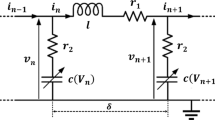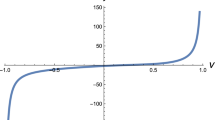Abstract
We consider a three-dimensional waveguide that is a small deformation of a periodically twisted tube (including in particular the case of a straight tube). The deformation is given by a bending and an additional twisting of the tube, both parametrized by a coupling constant \(\delta \). In this deformed waveguide, we consider the Dirichlet Laplacian. We expand its resolvent near the bottom of its essential spectrum, and we show the existence of exactly one resonance, in the asymptotic regime of \(\delta \) small. We are able to perform the asymptotic expansion of the resonance in \(\delta \), which in particular permits us to give a quantitative geometric criterion for the existence of a discrete eigenvalue below the essential spectrum. In the case of perturbations of straight tubes, we are able to show the existence of resonances not only near the bottom of the essential spectrum but near each threshold in the spectrum, showing in particular what are the spectral effects of the bending for higher energies. We also obtain the asymptotic behavior of the resonances in this situation, which is generically different from the first case.

Similar content being viewed by others
Notes
This notation is in agreement with the notation introduced in (7).
References
Bakharev, F.L., Exner, P.: Geometrically induced spectral effects in tubes with a mixed Dirichlet–Neumann boundary. Rep. Math. Phys. 81(2), 213–231 (2018)
Bony, J.-F., Bruneau, V., Raikov, G.: Resonances and spectral shift function near the Landau levels. Ann. Inst. Fourier 57(2), 629–672 (2007)
Briet, P., Hammedi, H., Krejčiřík, D.: Hardy inequalities in globally twisted waveguides. Lett. Math. Phys. 105, 939–958 (2015)
Briet, P., Kovařík, H., Raikov, G., Soccorsi, E.: Eigenvalue asymptotics in a twisted waveguide. Commun. Partial Differ. Equ. 34(7–9), 818–836 (2009)
Briet, P., Kovařík, H., Raikov, G.D.: Scattering in twisted waveguides. J. Funct. Anal. 266, 1–35 (2014)
Bruneau, V., Miranda, P., Popoff, N.: Resonances near thresholds in slightly twisted waveguides. Proc. Am. Math. Soc. 146(11), 4801–4812 (2018)
Chenaud, B., Duclos, P., Freitas, P., Krejčiřík, D.: Geometrically induced discrete spectrum in curved tubes. Differ. Geom. Appl. 23(2), 95–105 (2005)
Clark, I.J., Bracken, A.J.: Bound states in tubular quantum waveguides with torsion. J. Phys. A Math. Gen. 29(15), 4527 (1996)
Duclos, P., Exner, P., Meller, B.: Exponential bounds on curvature-induced resonances in a two-dimensional Dirichlet tube. Helv. Phys. Acta 71(2), 133–162 (1998)
Duclos, P., Exner, P.: Curvature-induced bound states in quantum waveguides in two and three dimensions. Rev. Math. Phys. 7(1), 73–102 (1995)
Ekholm, T., Kovařík, H., Krejčiřík, D.: A hardy inequality in twisted waveguides. Arch. Ration. Mech. Anal. 188(2), 245–264 (2008)
Exner, P., Kovařík, H.: Quantum Waveguides. Theoretical and Mathematical Physics. Springer, Berlin (2015)
Exner, P., Kovařík, H.: Spectrum of the Schrödinger operator in a perturbed periodically twisted tube. Lett. Math. Phys. 73(3), 183–192 (2005)
Froese, R.: Asymptotic distribution of resonances in one dimension. J. Differ. Equ. 137(2), 251–272 (1997)
Grushin, V.V.: On the eigenvalues of finitely perturbed laplace operators in infinite cylindrical domains. Math. Notes 75(3–4), 331–340 (2004)
Grushin, V.V.: Asymptotic behavior of the eigenvalues of the Schrödinger operator with transversal potential in a weakly curved infinite cylinder. Math. Notes 77, 606–613 (2005)
Krejčiřík, D.: Twisting versus bending in quantum waveguides. In: Exner, P., Keating, J.P., Kuchment, P., Teplyaev, A., Sunada, t. (eds.) Analysis on Graphs and Its Applications, volume 77 of Proceedings of Symposium on Pure Mathematics, pp. 617–637. American Mathematical Society, Providence, RI (2008)
Krejčiřík, D., Šediváková, H.: The effective Hamiltonian in curved quantum waveguides under mild regularity assumptions. Rev. Math. Phys. 24(7), 1250018, 39 (2012)
Melrose, R.B.: Geometric Scattering Theory. Stanford Lectures. Cambridge University Press, Cambridge (1995)
Nazarov, S.A.: Scattering anomalies in a resonator above the thresholds of the continuous spectrum. Mat. Sb. 206(6), 15–48 (2015)
Nedelec, L.: Sur les résonances de l’opérateur de dirichlet dans un tube. Commun. Partial Differ. Equ. 22(1–2), 143–163 (1997)
Reed, M., Simon, B.: Methods of Modern Mathematical Physics, vol. III. Scattering Theory. Bulletin of the American Mathematical Society, vol. 2, pp. 0273–0979 (1980)
Simon, B.: Resonances in one dimension and Fredholm determinants. J. Funct. Anal. 178(2), 396–420 (2000)
Uhlenbeck, K.: Generic properties of eigenfunctions. Am. J. Math. 98(4), 1059–1078 (1976)
Yafaev, D.R.: Mathematical Scattering Theory, volume 105 ofTranslations of Mathematical Monographs. American Mathematical Society, Providence, RI (1992) (General theory, Translated from theRussian by J. R. Schulenberger)
Zworski, M.: Distribution of poles for scattering on the real line. J. Funct. Anal. 73(2), 277–296 (1987)
Author information
Authors and Affiliations
Corresponding author
Additional information
Communicated by Jan Derezinski.
Publisher's Note
Springer Nature remains neutral with regard to jurisdictional claims in published maps and institutional affiliations.
Appendix A: Some Explicit Expansions
Appendix A: Some Explicit Expansions
1.1 A.1: The Perturbation as a Second-Order Differential Operator
In this appendix, we give some explicit computations that are straightforward. For simplicity, we set \(\xi (s):=\tau (s)-\epsilon (s)-\beta \). Also, it is easy to see that \(h(s,t)=1-\kappa (s)(t_2\cos (\theta (s))+t_3\sin (\theta (s)))\) satisfies
With this, we can start computing an expression for W. Here we systematically use the notation \({\dot{f}}=\partial _s f\) and \({\tilde{f}}=\partial _\varphi f\). By definition, we have
Noticing that
we get
Then, writing
we obtain
1.2 A.2: Asymptotics of the Coefficient in the Perturbative Regime
We are now interested in the asymptotic behavior of \(\langle \eta \otimes \psi _n|\eta ^{-1}W_\delta \psi _n\rangle =\langle \psi _n|W_\delta \psi _n\rangle \) as \(\delta \rightarrow 0\). For this, we need to make appear the \(\delta \)-dependence in the previous expressions. We set \(\xi _\delta (s)=\delta \tau (s)-\delta \epsilon (s)-\beta \) and introduce the auxiliary function \(\Xi _\delta (s):=\xi _\delta (s)+\beta =\delta \tau (s)-\delta \epsilon (s)=:\delta \Xi (s)\). Furthermore, setting \(E(s)=\int _{-\infty }^s\epsilon (s)\mathrm{d}s\) we get the expression \(\theta _\delta (s)=\beta s+\delta E(s)\). Before studying \(\langle \psi _n|W_\delta \psi _n\rangle \), we need the asymptotic behavior of \(h_\delta (s,t)=1-\delta \kappa (s)(t_2\cos (\theta _\delta (s))+t_3\sin (\theta _\delta (s)))\) given by
where
We will also need the fact that:
The relation \(\partial _\varphi h={\tilde{h}}\) gives the corresponding asymptotic for \({\tilde{h}}_\delta \)
where \({\tilde{g}}_i=\partial _\varphi g_i\).
Lemma 16
Under the assumptions of decay of \(\kappa ,\tau ,\varepsilon \) and its derivatives (see (9)), we have the following asymptotic:
The constant \(\breve{\mu }_{1,n}\) is given by
where \(\vartheta (s,t)\) is given by
Assume, moreover, that \(\beta =0\). Then, \(\breve{\mu }_{1,n}=0\) and \(\breve{\mu }_{2,n}\) is given by
Proof
In order to compute the differential operator in the r.h.s. of (48) applied to \(\psi _n\), since \(\partial _s \psi _n=0\), we only need the expansions of \(f_{0,j}\) for \(j\in \{0,1,2\}\):
This in turn gives
The higher-order terms are
and
Let us now compute \(\breve{\mu }_{1,n}\) when \(\beta \ne 0\). Notice that for any function \({\mathbb {R}}\times \omega \ni (s,t)\rightarrow F(s,t)\) such that \({\dot{F}}(\cdot ,t)\) is integrable for every \(t\in \omega \), we have \(\langle {\dot{F}}\psi _n,\psi _n\rangle =0\) for every \(1\le n\le \infty \). Therefore, we have
An integration by parts provides
Combining these results, we get
from where one easily deduces the expression for \(\breve{\mu }_{1,n}\).
Assume now that \(\beta =0\). It is clear from (55) that \(\mu _{1,n}=0\). Let us now compute the expression of \(\mu _{2,n}\). We have
where we have used an integration by parts in s and that \(\int _{{\mathbb {R}}} {\dot{\Xi }}\tilde{g_1}+\dot{\tilde{g_1}}\Xi =0\). Moreover,
Combining (56) and (57) and integrating by parts, we deduce \(\breve{\mu }_{2,n}\) by
\(\square \)
Rights and permissions
About this article
Cite this article
Bruneau, V., Miranda, P., Parra, D. et al. Eigenvalue and Resonance Asymptotics in Perturbed Periodically Twisted Tubes: Twisting Versus Bending. Ann. Henri Poincaré 21, 377–403 (2020). https://doi.org/10.1007/s00023-019-00865-5
Received:
Accepted:
Published:
Issue Date:
DOI: https://doi.org/10.1007/s00023-019-00865-5




